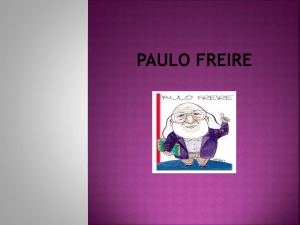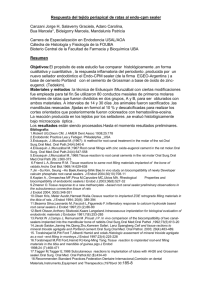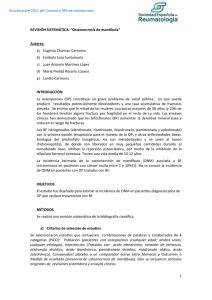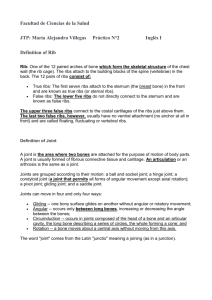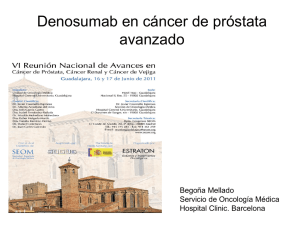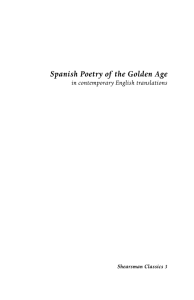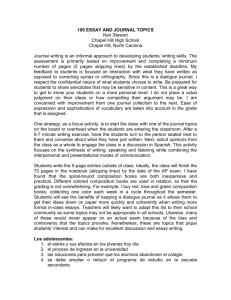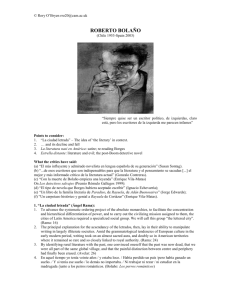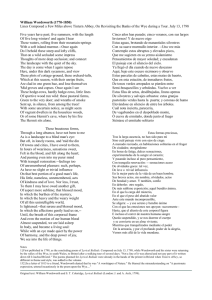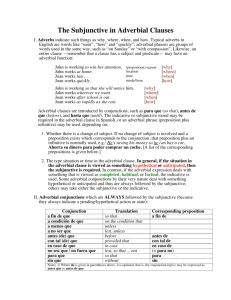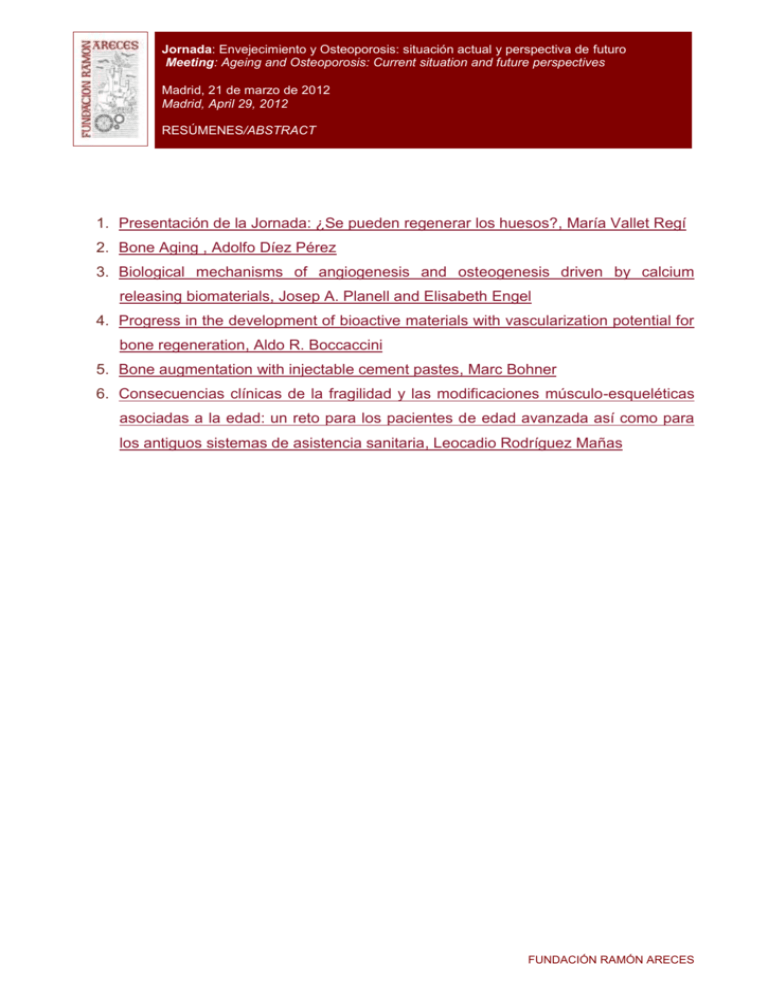
Jornada: Envejecimiento y Osteoporosis: situación actual y perspectiva de futuro
Meeting: Ageing and Osteoporosis: Current situation and future perspectives
Madrid, 21 de marzo de 2012
Madrid, April 29, 2012
RESÚMENES/ABSTRACT
1. Presentación de la Jornada: ¿Se pueden regenerar los huesos?, María Vallet Regí
2. Bone Aging , Adolfo Díez Pérez
3. Biological mechanisms of angiogenesis and osteogenesis driven by calcium
releasing biomaterials, Josep A. Planell and Elisabeth Engel
4. Progress in the development of bioactive materials with vascularization potential for
bone regeneration, Aldo R. Boccaccini
5. Bone augmentation with injectable cement pastes, Marc Bohner
6. Consecuencias clínicas de la fragilidad y las modificaciones músculo-esqueléticas
asociadas a la edad: un reto para los pacientes de edad avanzada así como para
los antiguos sistemas de asistencia sanitaria, Leocadio Rodríguez Mañas
FUNDACIÓN RAMÓN ARECES
Jornada: Envejecimiento y Osteoporosis: situación actual y perspectiva de futuro
Meeting: Ageing and Osteoporosis: Current situation and future perspectives
Madrid, 21 de marzo de 2012
Madrid, April 29, 2012
RESÚMENES/ABSTRACT
Presentación de la Jornada: ¿Se pueden regenerar los huesos?
María Vallet Regí
El envejecimiento de nuestros cuerpos como consecuencia del paso del tiempo, obliga a
buscar soluciones, cada vez más urgentes porque cada vez es mayor el número de
ciudadanos que llegan a edades muy avanzadas donde, problemas como la osteoporosis,
van emparejados a su envejecimiento. La búsqueda de un objetivo común, remediar el
dolor, la enfermedad, y el deterioro de nuestros cuerpos, obliga a investigar y diseñar en
biomateriales y nanoestructuras. En esta jornada vamos a debatir si es posible regenerar
los huesos, y que soluciones intermedias o alternativas existen para ello.
VOLVER ↑
Bone Aging
Adolfo Díez Pérez
Bone is a highly complex system. Among their several functions, is obvious its rol as a
scaffold and protective structure of the different organs. Moreover, is where hematopoietic
medulla is hosted. Metabolically, constitutes the main reservoir of minerals, available for
the regulation of biochemical and signaling functions. More recently, has been described
its role as an endocrine organ, able to secrete systemic hormones. All these complex
functions are made possible by a highly sophisticated and very active cellular system. The
three cell lines in charge of these functions are: 1) The osteoclast, derived from the
hematopoietic precursor cell, with macrophage function; 2) The osteoblast, derived from a
common mesenchimal precursor that, besides osteoblasts, can differentiate alternatively
to adipocyte, chondrocyte, myoblast or fibroblast, and 3) The osteocyte, the most
abundant bone cell, in charge of the regulatory effects, both locally and systemic.
FUNDACIÓN RAMÓN ARECES
Jornada: Envejecimiento y Osteoporosis: situación actual y perspectiva de futuro
Meeting: Ageing and Osteoporosis: Current situation and future perspectives
Madrid, 21 de marzo de 2012
Madrid, April 29, 2012
RESÚMENES/ABSTRACT
Aging has an impact on bone tissue in several ways. There is a decline in trophic
elements, importantly the gonadal hormones (menopause, andropause). A breakdown of
the cellular equilibrium between formation and resorption, in the remodeling cycle, causing
negative balance and the subsequent bone loss is also produced. Moreover, there is an
intrinsic functional decline in the activity of the bone cells. Finally, deterioration in the
different components of the constituent materials (collagen, fatigue damage) weakens the
mechanical competence of the tissue.
Like other elements of our physiology, bone has adapted during the evolution to a life span
of 4-5 decades. The dramatic increase n the life expectancy in the last century has
produced a functional challenge that constitutes the ground for the progressive importance
of the osteoporosis and explains their morbidity and mortality. However, from an
integrative perspective, bone deterioration is a part of the decline in the bone-muscle-joint
unit. These three structures are integrated in a common function and the involution in any
of them (osteoporosis, sarcopenia, osteoarthritis) merges in one of the main drivers of the
frailty syndrome. This frailty is, at the end, a decrease in the autonomy and functional
reserve of the individual, with a striking increase in their vulnerability.
There is a considerable genetic load behind the development of this aging-associated
decline. However, a large variety of external factors can modulate the genetic
predisposition either accelerating or delaying the physiological deterioration. When facing
this clinical challenge, it is very important to integrate all the different pieces that play a
role in the bone-muscle-joint functional unit and manage the problem in an integrated
fashion. This is the key strategy for expanding a healthy life, with independence and good
quality. In this manner, we could palliate the personal, social and economic burden that
this aging process implies. We do have tools and knowledge to face the challenge.
VOLVER ↑
FUNDACIÓN RAMÓN ARECES
Jornada: Envejecimiento y Osteoporosis: situación actual y perspectiva de futuro
Meeting: Ageing and Osteoporosis: Current situation and future perspectives
Madrid, 21 de marzo de 2012
Madrid, April 29, 2012
RESÚMENES/ABSTRACT
Biological mechanisms of angiogenesis and osteogenesis driven by calcium releasing
biomaterials
Josep A. Planell and Elisabeth Engel
It is well known that the mineral phase of bone is formed mainly by a carbonated apatite
[Ca10-(PO4)6(OH)2]. Using this fact, numerous calcium phosphate–containing ceramics,
glass ceramics, and biological glasses have been developed for the repair and
reconstruction of the bony tissue. Bioactive glasses have shown to be promising materials
for the skeletal system healing, especially in vivo, where they have induced a rapid and
beneficial response. A majority of these bioactive glasses is SiO 2-based exhibiting a range
of low dissolution rates. In contrast, phosphate bioabsorbable glasses have the ability to
solubilize completely, and their degradation time may vary from few days to several
months. Such glasses are good candidates as reinforcement phase for biodegradable
composite materials for the construction of scaffolds for tissue engineering.
The CaP glass of the 44,5P2O5 – 44,5CaO – 6Na2O – 5TiO2 (molar composition) system,
coded G5, has shown a good chemical stability and good mechanical properties. In vitro
degradation studies on the G5-glass performed with SBF at physiological temperature
showed that G5-glass dissolution occurs uniformly, which means that none of the ions
forming the glass network is released preferentially.
The incorporation of an inorganic phase into the polymeric matrix may enhance the
mechanical integrity of the material, as well as its biological behavior, and can also modify
the degradation mechanism of the polymer. Some calcium phosphate ceramics and
biological glasses have been used with this aim. Specifically, calcium phosphate (CaP)
glasses are well suited for bone remodeling given that they possess a chemical
composition close to that of the mineral phase of bone and that their solubility rate can be
adjusted by controlling their chemical composition.
FUNDACIÓN RAMÓN ARECES
Jornada: Envejecimiento y Osteoporosis: situación actual y perspectiva de futuro
Meeting: Ageing and Osteoporosis: Current situation and future perspectives
Madrid, 21 de marzo de 2012
Madrid, April 29, 2012
RESÚMENES/ABSTRACT
The success of a 3D scaffold depends on several parameters that range from the macroto the nanoscale. Macro- and microporosity, as well as interconnectivity, are of great
importance in promoting tissue ingrowth, vascularization, and the delivery of nutrients
throughout the newly formed tissue. The attachment and adhesion of the cells on the
material surface are protein mediated processes, where factors such as surface chemistry,
surface energy, and topography can affect the cell material response.
In vitro studies have shown that the biological properties of this bioactive, biodegradable
calcium phosphate glass/polylactic acid composite biomaterial promote bone marrowderived endothelial progenitor cell (EPC) mobilization, differentiation and angiogenesis
through the creation of a controlled bone healing-like microenvironment. The angiogenic
response is triggered by biochemical and mechanical cues provided by the composite,
which activate two synergistic cell signaling pathways: a biochemical one mediated by the
calcium-sensing receptor and a mechanosensitive one regulated by non-muscle myosin II
contraction. Together, these signals promote a synergistic response by activating EPCsmediated VEGF and VEGFR-2 synthesis, which in turn promote progenitor cell homing,
differentiation and tubulogenesis. These findings highlight the importance of controlling
microenvironmental cues for stem/progenitor cell tissue engineering and offer exciting new
therapeutical opportunities for biomaterial-based vascularisation approaches and clinical
applications.
This is the first time that a composite containing a bioactive, biodegradable glass has been
proven to be directly involved in angiogenesis and differentiation of endothelial
progenitors. The main advantages of this approach (when compared to others such as
protein immobilization or growth factor release) are the simplicity of material fabrication,
low cost and off-the-shelf availability, making it a very attractive strategy for clinical
applications involving musculoskeletal repair.
Related to osteogenesis, in vitro studies revealed the induction of Mesenchymal Stem
Cells proliferation, migration and differentiation towards osteogenic lineage and promoting
FUNDACIÓN RAMÓN ARECES
Jornada: Envejecimiento y Osteoporosis: situación actual y perspectiva de futuro
Meeting: Ageing and Osteoporosis: Current situation and future perspectives
Madrid, 21 de marzo de 2012
Madrid, April 29, 2012
RESÚMENES/ABSTRACT
Alkaline Phosphatase activity and Collagen type I production at early times (3 an 7 days)
in absence of osteogenic media. Also, the induction of mineralization is remarkable when
there is a high extracellular calcium concentration (10 mM). In vivo studies have shown
that the addition of calcium phosphate glass (G5) to PLA results in a composite material
with higher angiogenic capacity than that of PLA only.
Taken all together, there is an important evidence of how biomaterials based in calcium
phosphates drive the bone tissue regeneration, inducing together osteogenesis and
angiogenesis.
VOLVER ↑
Progress in the development of bioactive materials with vascularization potential for bone
regeneration
Aldo R. Boccaccini
Multifunctional scaffolds for application in bone regeneration approaches will be discussed,
presenting recent progress and remaining challenges. After summarizing current research
in the field of scaffolds for bone tissue engineering, recent results on the development and
characterisation of nanostructured bioactive glass scaffolds, coated and infiltrated with
biopolymers, will be presented. Technologies for fabrication foam-like bone scaffolds will
be discussed highlighting the versatility of the foam replica technique for developing
scaffolds that mimic trabecular bone structure. Advanced methods based on rapid
prototyping and electropspinning techniques will be also considered. The contribution of
biomaterials science to the tissue engineering field will be considered based on the
optimization of the structure, surface properties, degradation behavior and mechanical
properties of the scaffolds. For example, the coating and infiltration of bioactive glass
FUNDACIÓN RAMÓN ARECES
Jornada: Envejecimiento y Osteoporosis: situación actual y perspectiva de futuro
Meeting: Ageing and Osteoporosis: Current situation and future perspectives
Madrid, 21 de marzo de 2012
Madrid, April 29, 2012
RESÚMENES/ABSTRACT
scaffolds by biodegradable polymers containing functionalised nanoscale inorganic
particles of nanofibres increases the fracture resistance of scaffolds and induces the
formation of nanostructured hydroxyapatite when immersed in simulated body fluid. In-vitro
characterisation methods for bone scaffolds will be presented, discussing the effects of
bioactive glass dissolution products on cell behaviour in relation to osteogenesis and
angiogenesis. Recent in-vivo results which have assessed the vascularisation potential of
new scaffolds based on bioactive glasses will be discussed and the present challenges of
this branch of tissue engineering will be highlighted, e.g. the development of vascularised
bone. The fabrication of novel scaffolds doped with trace elements (e.g. Sr, Cu) and
investigations on the effect of these elements on the scaffold biological performance will
be presented which provide experimental evidence to support the hypothesis that scaffolds
with specific ion release capability (bioinorganics or therapeutic metallic ions) are attractive
for bone tissue engineering. In this context, nanostructuring strategies for 3D bioactive
glass (or glass-ceramic) scaffolds will be discussed, which are being investigated to
support the attachment and proliferation of relevant cells. Areas of future research in the
field of bioactive materials based on smart systems for engineering tissues requiring
enhanced vascularisation will be addressed, including the emerging fields of tissue
engineering therapeutics and regeneration of complex tissue interfaces.
VOLVER ↑
Bone augmentation with injectable cement pastes
Marc Bohner
Osteoporotic bone fractures are often difficult to treat because the bone quality is so poor
that fixation screws do not hold. As a result, broken bone pieces cannot be fixed properly.
One strategy to remedy to this problem is to reinforce bone with an injectable cement
FUNDACIÓN RAMÓN ARECES
Jornada: Envejecimiento y Osteoporosis: situación actual y perspectiva de futuro
Meeting: Ageing and Osteoporosis: Current situation and future perspectives
Madrid, 21 de marzo de 2012
Madrid, April 29, 2012
RESÚMENES/ABSTRACT
paste, and then place the fixation screws. Generally, poly(methyl methacrylate) (PMMA) is
used for that purpose. This material has interesting mechanical properties and is cheap,
but it has various drawbacks, such as a toxic monomer, a limited biocompatibility, and an
absence of biodegradation. Efforts have been made in the past 20 years to replace PMMA
with biodegradable cements. Particularly interesting candidates are calcium phosphate
cements (CPCs). Unfortunately, CPCs tend to have poor rheological properties and are
fairly weak mechanically. Furthermore, CPCs are expensive and do not have much
radiographical contrast. The aim of my talk will be to give an overview on the use of
injectable cement pastes for bone augmentation procedures.
VOLVER ↑
Consecuencias clínicas de la fragilidad y las modificaciones músculo-esqueléticas
asociadas a la edad: un reto para los pacientes de edad avanzada así como para los
antiguos sistemas de asistencia sanitaria
Leocadio Rodríguez Mañas
Ya en el año 2001 y nuevamente en el 2012 (Fact sheet nº 344), la Organización Mundial
de la Salud (OMS) alarma sobre la gran prevalencia de las caídas así como de la
severidad de sus consecuencias llegando a ser la segunda causa de muerte accidental en
población general. Sin embargo, son los mayores de 65 años los que sufren el mayor
número de caídas fatales alcanzando en este grupo etáreo la primera causa de muerte
accidental. Con estos alarmantes datos la OMS enfatiza la necesidad de promover
políticas de prevención de caídas que deberían basarse en la educación poblacional, el
entrenamiento específico de personal sanitario, la creación de ambientes y entornos
seguros y la priorización de líneas de investigación en este campo.
Entre los mayores de 65 años, el 30% sufren al menos una caída al año (de estos el 50%
sufren caídas de repetición). De los pacientes que se caen el 10% sufren una
consecuencia severa de la caída (fracturas, hematoma subdurales, síndrome post-caída,
FUNDACIÓN RAMÓN ARECES
Jornada: Envejecimiento y Osteoporosis: situación actual y perspectiva de futuro
Meeting: Ageing and Osteoporosis: Current situation and future perspectives
Madrid, 21 de marzo de 2012
Madrid, April 29, 2012
RESÚMENES/ABSTRACT
etc), el 5-6% sufren una fractura y sólo el 1% sufre fractura de cadera. Y, por último, de
los pacientes que sufren fractura de cadera, el 5% fallecen durante el ingreso, el 30%
fallecen durante el primer año y, al menos, el 50% no recuperan su situación funcional
previa. (Age Ageing 1988;17:365-72. N Engl J Med 1988;319:1701-7. Am J Epidemiol
1996;143:1129-36. Canadian senior`s report, 2005).
Estos datos epidemiológicos han contribuido a que diferentes Servicios de Salud
prioricen líneas de acción en este campo, promoviendo la creación de Unidades de
Caídas y Fracturas, donde se integran estrategias de prevención de caídas, manejo de la
osteoporosis y cuidado después de la caída y/o fractura (National Service Framework for
Older People. National Health Service). Numerosos trabajos se han realizado en los
últimos años para evaluar dichas estrategias en diferentes ámbitos. En el ámbito
hospitalario las Unidades de Ortogeriatría (diseñadas en el Reino Unido para el
seguimiento de los pacientes ancianos con fractura de cadera) y las consultas de
valoración de riesgo de caídas con intervenciones basadas en ejercicio físico tienen un
nivel de evidencia A. En el medio residencial la suplementación con vitamina D es la
medida más costo-efectiva (6 dólares australianos por caída evitada, 80 dólares por
hospitalización evitada); en este medio también resultaron efectivas la revisión de la
medicación y las intervenciones múltiples. En el medio comunitario la medida más costoefectiva fue el Tai-chi (239 dólares australianos por caída evitada, 5179 dólares por
hospitalización evitada); el cribado de caídas seguido de la derivación a las consultas de
caídas y la revisión de medicación psicotropa también resultaron efectivas en este medio.
VOLVER ↑
*Todos los derechos de propiedad intelectual son del autor. Queda prohibida la reproducción total o parcial de la obra sin autorización
expresa del autor.
© FUNDACIÓN RAMÓN ARECES. Todos los derechos reservados.
*All intellectual property rights belong to the author. Total or partial reproduction of the work without express permission of the author is
forbidden.
© FUNDACIÓN RAMÓN ARECES. All rights reserved.
FUNDACIÓN RAMÓN ARECES


